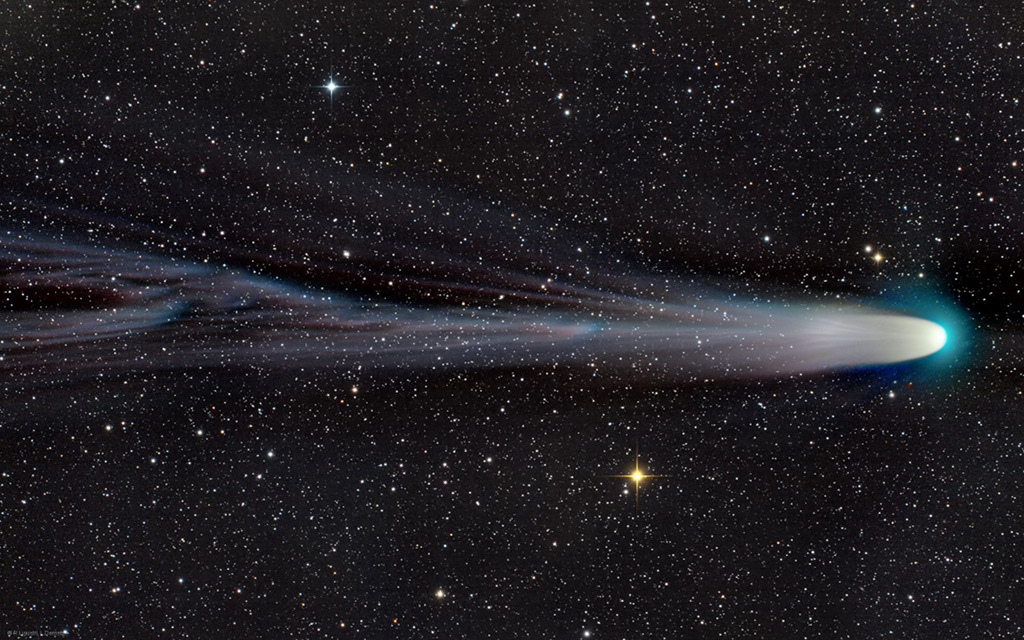Blog
The lonely spiral galaxy UGC 9391 is shown in this image from the NASA/ESA Hubble Space Telescope’s Wide Field Camera 3. This galaxy resides 130 million light-years from Earth in the constellation Draco near the north celestial pole. The star-studded spiral arms stand in splendid isolation against a backdrop of distant galaxies, which are only visible as indistinct swirls or smudges thanks to their vast distances from Earth. The image also features some much brighter foreground stars closer to home. These bright nearby stars are ringed with diffraction spikes — prominent spikes caused by light interacting with the inner workings of Hubble’s complicated optics. This image is from a set of Hubble observations which astronomers used to construct the “Cosmic Distance Ladder” — a set of connected measurements allowing the distances to the most distant astronomical objects to be determined. Astronomical distances are only directly measurable for relatively nearby objects — closer than 3000 light-years or so. For distances beyond this, astronomers rely on a set of measured correlations calibrated against nearby objects. UGC 9391 helped astronomers improve their distance estimates by providing a natural laboratory in which to compare two measuring techniques — supernova explosions and Cepheid variables. Improving the precision of distance measurements helps astronomers quantify how quickly the Universe is expanding — one of Hubble’s key science goals.

Tracy Nelson (born December 27, 1944) is an American country and blues singer. She has been involved in the recording of over 20 albums in her recording career, which started in 1965.
Nelson was born and grew up in Madison, Wisconsin, United States. There, she first learned about R&B music from nighttime listening to WLACradio from Nashville, Tennessee. In her teens, Nelson sang folk music in coffeehouses and with The Fuller-Wood Singers group, and was lead singer in The Fabulous Imitations band. She attended the University of Wisconsin as a social science major.
more...Thelonious Sphere “T. S.” Monk III (born December 27, 1949) is an American jazz drummer, composer and bandleader. He is the son of jazz pianist Thelonious Monk.
Born in New York City, he began his music career early in his life, honing his skills throughout the 1970s. Monk’s destiny was sealed when Art Blakey gave him his first drum set at the age of 15, and began lessons with Max Roach. After earning a reputation in school as a rabble-rouser (and graduating), the young Monk joined his father’s trio and toured with his dad until the elder Monk’s retirement in 1975. Monk then launched into the music that had captivated him and his generation, R&B. He first toured with a group called Natural Essence and afterward, along with his sister Barbara, formed his own band.
By the dawning of the 1980s, he had formed his eponymous band, which featured him on drums and occasional lead vocals. The group’s début album, 1980’s House of Music, featured several hits that placed on the Billboard R&B chart, including “Bon Bon Vie (Gimme the Good Life)“, which featured Monk on lead vocals, and “Candidate for Love”. The tracks peaked at No. 63 and No. 58 respectively, in the UK Singles Chart. The band went on to release two more albums throughout the early 1980s, though singles released from these albums did not fare as well as those on the début. The band broke up shortly thereafter.
more...Johnny Frigo (December 27, 1916 – July 4, 2007) was an American jazz violinist and bassist. He appeared in the 1940s as a violinist before working as a bassist. He returned to the violin in the 1980s and enjoyed a comeback, recording several albums as a leader.
Frigo was born in Chicago and studied violin for three years beginning at age seven. In high school he started to play double bass in dance orchestras. In 1942 he played with Chico Marx‘s orchestra and performed a comedy routine on violin with Marx on piano. He entered the United States Coast Guard during World War II and played in a band on Ellis Island with Al Haig and Kai Winding.
After a brief turn at active service near the end of the war he moved to New Jersey. He toured with Jimmy Dorsey‘s band from 1945 to 1947, later forming the Soft Winds trio with Dorsey’s guitarist Herb Ellis and pianist Lou Carter. During this time he wrote the music and lyrics to “Detour Ahead”,which has been recorded by Billie Holiday, Sarah Vaughan, Ella Fitzgerald, Bill Evans, and Carola. During that time, he also wrote the sardonic swing tune “I Told Ya I Love Ya, Now Get Out” which was recorded by June Christy and the Stan Kenton Orchestra. Chicago jazz vocalist Erin McDougaldrecorded the song 50 years later on her album The Auburn Collection (2004).
more...Dardanelle Breckenbridge or Breckenridge (December 27, 1917 – August 8, 1997), was an American jazz musician known for performing with Lionel Hampton in the 1940s, and later as a solo artist under the name Dardanelle.
Dardanelle was a talented pianist, vibraphonist, and singer who was raised in a musical family. She studied music at Louisiana State University, holding a major, and worked as a house pianist at a local radio station. By the late 1930s she started to appear professionally on the national jazz scene. During the 1940s she led her own Dardanelle Trio, with various collaboraters, initially with bassist Paul Edenfield and guitarist Tal Farlow. The trio recorded much music and became a regular fixture at New York’s Copacabana. During this time she was featured in the 1946 short theatrical musical “Soundies Presents Happy Cat” directed by William Forest Crouch and distributed by RCA Records. By the 1950s Dardanelle moved to Chicago and paused music in favour of raising a family.
more...There’s a big new telescope in space. This one, the James Webb Space Telescope (JWST), not only has a mirror over five times larger than Hubble‘s in area, but can see better in infrared light. The featured picture shows JWST high above the Earth just after being released by the upper stage of an Ariane V rocket, launched yesterday from French Guiana. Over the next month, JWST will move out near the Sun-Earth L2 point where it will co-orbit the Sun with the Earth. During this time and for the next five months, JWST will unravel its segmented mirror and an array of sophisticated scientific instruments — and test them. If all goes well, JWST will start examining galaxies across the universe and planets orbiting stars across our Milky Way Galaxy in the summer of 2022.

John Scofield (born December 26, 1951), sometimes referred to as “Sco”, is an American jazz-rock guitarist and composer whose music includes bebop, jazz fusion, funk, blues, soul, and rock. He has worked with Miles Davis, Eddie Harris, Dave Liebman, Joe Henderson, Charles Mingus, Joey DeFrancesco, Herbie Hancock, Eddie Palmieri, Pat Metheny, Bill Frisell, Joe Lovano, Pat Martino, Mavis Staples, Phil Lesh, Billy Cobham, Medeski Martin & Wood, George Duke, Jaco Pastorius, John Mayer, Robert Glasper, and Gov’t Mule.
Scofield’s family left Ohio and moved to Wilton, Connecticut, where he discovered his interest in music. Educated at the Berklee College of Music, Scofield left school to record with Chet Baker and Gerry Mulligan. He joined the Billy Cobham/George Duke Band soon after and spent two years playing, recording, and touring with them. He recorded with Charles Mingus in 1976 and replaced Pat Metheny in Gary Burton‘s quartet.
more...George Winston (born December 26, 1949) is an American pianist. He was born in Michigan and raised mainly in Montana (Miles City and Billings),as well as Mississippi and Florida. He is best known for his solo piano recordings. Each of several of his albums from the early 1980s have sold millions of copies. He plays in three styles: the melodic approach he developed that he calls “rural folk piano”; stride piano, primarily inspired by Thomas “Fats” Waller and Teddy Wilson; and his primary interest, New Orleans R&B piano, influenced by James Booker, Professor Longhair, and Henry Butler.
When growing up, Winston’s musical interests lay with instrumentals of the R&B, rock, pop, and jazz genres, especially those by organists. After hearing The Doors in 1967, he was inspired to start playing the organ. In 1971, he switched to solo piano after hearing stride pianists Thomas “Fats” Waller, Teddy Wilson, and later Earl Hines, Donald Lambert, and Cleo Brown.
Winston attended Stetson University in DeLand, Florida, in the 1960s, where he majored in sociology. While he did not complete his undergraduate degree, following his rise to prominence the university awarded him an honorary doctor of arts degree.
more...Doug Hammond (born December 26, 1942) is an American free funk/avant-garde jazz drummer, composer, poet, producer, and professor. His first major release was Reflections in the Sea of Nurnen on Tribe Records in 1975.
He has worked with musicians including Earl Hooker, Sonny Rollins, Charles Mingus, Sammy Price, Donald Byrd, Wolfgang Dauner, Ornette Coleman, Steve Coleman, Nina Simone, Betty Carter, Marion Williams, Paquito D’Rivera, Arnett Cobb, James Blood Ulmer and Arthur Blythe.
In 2010 Doug Hammond wrote and conducted “Acknowledgement Suite” with Dwight Adams, Jean Toussaint, Roman Filiú, Howard Curtis, Wendell Harrison, Dick Griffin, Stéphane Payen, Kirk Lightsey and Arron James.
He was a professor at the Anton Bruckner Private University in Linz.
more...János Kőrössy (26 December 1926 – 21 January 2013) was a Romanian jazz musician of Hungarian descent. He was a piano player, composer and arranger.
He was born to an ethnic Hungarian family in Cluj. His first teacher was pianist and conductor Teodor Cosma, of whom he said, “I owe him everything, and for me the beginning is everything, the rest comes by itself.” Kőrössy was noted for combining the musical language typical of jazz with elements of local folk music, a trend referred to as ethno jazz. He arranged in jazz-style George Enescu‘s Romanian Rhapsody No. 1.
Kőrössy’s first name is spelled in many different ways: Hansel, Jancy, Jancsy, Iancsi, Yancy and Yancey. He became a well known jazz musician in the European Eastern bloc in the 1960s, appearing at the International Jazz Festivals in Prague (1960), Warsaw (1961) and Budapest (1962). In 1969 he moved to West Germany and subsequently relocated to the United States, settling in Atlanta, Georgia. He played in Atlanta and in 1981 performed with Zoot Sims. After the Romanian Revolution, he returned to Romania, appearing in 1993 at the Costineşti and Galaţi jazz festivals and 2001 at the International Jazz Festival in Bucharest.
more...Monte Rex Budwig (December 26, 1929 – March 9, 1992) was a West Coast jazz double bassist, professionally known as Monty Budwig. Monte Rex Budwig was born in Pender, Nebraska, on December 26, 1929. His parents were musical. He began playing bass during high school, and continued in military bands while he was enlisted in the Air Force for three years.
In 1954, Budwig moved to Los Angeles and performed and recorded under the name Monty Budwig with jazz musicians including Carmen McRae, Barney Kessel, Woody Herman, Red Norvo, and Shelly Manne. Budwig played with pianist Vince Guaraldi in the 1960s, including on the pianist’s album Jazz Impressions of Black Orpheus. Budwig was part of Benny Goodman‘s band for performances in New York, and a tour of Japan in 1964. He also began his career as a studio musician in the 1960s, which encompassed film and television shows, with Steve Allen, Johnny Carson, Merv Griffin and Judy Garland. Budwig taught jazz bassist Scott Colley, then a teenager.
more...
The tail of a comet streams across this three degree wide telescopic field of view captured under dark Namibian skies on December 21. In outburst only a few days ago and just reaching naked eye visibilityComet Leonard (C/2021 A1) is this year’s brightest comet. Binoculars will make the diffuse comet easier to spot though, close to the western horizon after sunset. Details revealed in the sharp image show the comet’s coma with a greenish tinge, and follow the interaction of the comet’s ion tail with magnetic fields in the solar wind. After passing closest to Earth on December 12 and Venus on December 18, Comet Leonard is heading toward perihelion, its closest approach to the Sun on January 3rd. Appearing in late December’s beautiful evening skies after sunset, Comet Leonard has also become known as 2021’s Christmas Comet.

more...
David Noel Redding (25 December 1945 – 11 May 2003) was an English rock musician, best known as the bass player for the Jimi Hendrix Experience and guitarist/singer for Fat Mattress.
Following his departure from the Experience in 1969 and the dissolution of Fat Mattress in 1970, Redding formed the short-lived group Road in the United States, which released the self-titled album Road before he re-located to Clonakilty, Ireland, in 1972. There he formed the Noel Redding Band with former Thin Lizzy guitarist Eric Bell, with whom he released two albums. Although by the 1980s Redding had largely removed himself from the music business, he would later perform around his new hometown with wife Carol Appleby.
He was inducted into the Rock and Roll Hall of Fame as a member of the Jimi Hendrix Experience in 1992. Redding was found dead in his home in Clonakilty on 11 May 2003, three weeks after the death of his mother.A postmortem was carried out on 13 May at Cork University Hospital in Wilton, Cork. The report concluded that Redding died from “shock haemorrhage due to oesophageal varices in reaction to cirrhosis of the liver”. He was 57 years old; he was survived by a brother, a sister, and a son, Nicolas Noel Redding, by his former wife, Danish-born Susanne.
more...
More Posts
- 60th Anniversary of Bloody Sunday
- How Far Will It Go
- Echos of Freedom Coretta Scott King
- Cosmo Blue Ghost
- Samuel Barber
- Lloyd Price
- Zakir Hussain
- Ornette Coleman
- World Music Jam & Zaki Project
- Daily Roots The Observers
- Ukraine Shark
- International Women’s Day 2025
- Mississippi John Hurt
- Cosmo Milky Way LMC SMC
- Richard Fariña
- Johnny Ventura
- Gábor Szabó
- George Coleman
- Ina Boyle
- World Music Andalucious
